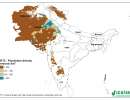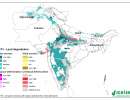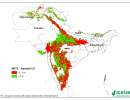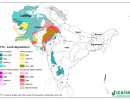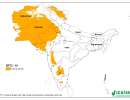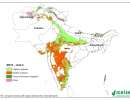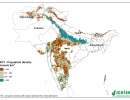GIS Data
Maps in: South Asia
SRT2-type drylands: population density
Gridded Population of the World, version 3 (GPWv3)
Center for International Earth Science Information Network (CIESIN), Columbia University; and Centro Internacional de Agricultura Tropical (CIAT). 2005. Gridded Population of the World Version 3 (GPWv3). Palisades, NY: Socioeconomic Data and Applications Center (SEDAC), Columbia University. Available at http://sedac.ciesin.columbia.edu/gpw.
Population Density Grids
Center for International Earth Science Information Network (CIESIN), Columbia University; and Centro Internacional de Agricultura Tropical (CIAT). 2005. Gridded Population of the World Version 3 (GPWv3): Population Density Grids. Palisades, NY: Socioeconomic Data and Applications Center (SEDAC), Columbia University. Available at http://sedac.ciesin.columbia.edu/gpw.
Metadataclose[x]
SRT2-type drylands: population density
Gridded Population of the World, version 3 (GPWv3)
Center for International Earth Science Information Network (CIESIN), Columbia University; and Centro Internacional de Agricultura Tropical (CIAT). 2005. Gridded Population of the World Version 3 (GPWv3). Palisades, NY: Socioeconomic Data and Applications Center (SEDAC), Columbia University. Available at http://sedac.ciesin.columbia.edu/gpw.
Population Density Grids
Center for International Earth Science Information Network (CIESIN), Columbia University; and Centro Internacional de Agricultura Tropical (CIAT). 2005. Gridded Population of the World Version 3 (GPWv3): Population Density Grids. Palisades, NY: Socioeconomic Data and Applications Center (SEDAC), Columbia University. Available at http://sedac.ciesin.columbia.edu/gpw.
SRT3-type drylands: land degradation
Metadataclose[x]
SRT3-type drylands: land degradation
SRT2-type drylands: land degradation
Metadataclose[x]
SRT2-type drylands: land degradation
SRT2-type drylands: aridity index
| Value | Climate Class |
|
<
0.03 |
Hyper Arid |
|
0.03 –
0.2 |
Arid |
|
0.2 –
0.5 |
Semi-Arid |
|
0.5 –
0.65 |
Dry sub-humid |
|
> 0.65
|
Humid |
Metadataclose[x]
SRT2-type drylands: aridity index
| Value | Climate Class |
|
<
0.03 |
Hyper Arid |
|
0.03 –
0.2 |
Arid |
|
0.2 –
0.5 |
Semi-Arid |
|
0.5 –
0.65 |
Dry sub-humid |
|
> 0.65
|
Humid |
SRT3-type drylands: land use/land cover
Overview
The GLOBCOVER project was launched 2004 as an initiative of ESA which is now evolving to an international collaboration between ESA, FAO, UNEP, JRC, IGBP and GOFC-GOLD. The objective of GLOBCOVER is to produce a global land-cover map for the year 2005, using as main source of data the fine resolution (300 m) mode data from MERIS sensor on-board ENVISAT satellite, acquired over the full year 2005. This new product intends to complement and update other existing comparable global products, such as the global land cover map for the year 2000 (GLC 2000) with a resolution of 1 km produced by the JRC. Appropriate approaches for the validation of the land cover products are planned to be defined in consultation with CEOS.
Metadataclose[x]
SRT3-type drylands: land use/land cover
Overview
The GLOBCOVER project was launched 2004 as an initiative of ESA which is now evolving to an international collaboration between ESA, FAO, UNEP, JRC, IGBP and GOFC-GOLD. The objective of GLOBCOVER is to produce a global land-cover map for the year 2005, using as main source of data the fine resolution (300 m) mode data from MERIS sensor on-board ENVISAT satellite, acquired over the full year 2005. This new product intends to complement and update other existing comparable global products, such as the global land cover map for the year 2000 (GLC 2000) with a resolution of 1 km produced by the JRC. Appropriate approaches for the validation of the land cover products are planned to be defined in consultation with CEOS.
SRT3-type drylands: population density
Gridded Population of the World, version 3 (GPWv3)
Center for International Earth Science Information Network (CIESIN), Columbia University; and Centro Internacional de Agricultura Tropical (CIAT). 2005. Gridded Population of the World Version 3 (GPWv3). Palisades, NY: Socioeconomic Data and Applications Center (SEDAC), Columbia University. Available at http://sedac.ciesin.columbia.edu/gpw.
Population Density Grids
Center for International Earth Science Information Network (CIESIN), Columbia University; and Centro Internacional de Agricultura Tropical (CIAT). 2005. Gridded Population of the World Version 3 (GPWv3): Population Density Grids. Palisades, NY: Socioeconomic Data and Applications Center (SEDAC), Columbia University. Available at http://sedac.ciesin.columbia.edu/gpw.
Metadataclose[x]
SRT3-type drylands: population density
Gridded Population of the World, version 3 (GPWv3)
Center for International Earth Science Information Network (CIESIN), Columbia University; and Centro Internacional de Agricultura Tropical (CIAT). 2005. Gridded Population of the World Version 3 (GPWv3). Palisades, NY: Socioeconomic Data and Applications Center (SEDAC), Columbia University. Available at http://sedac.ciesin.columbia.edu/gpw.
Population Density Grids
Center for International Earth Science Information Network (CIESIN), Columbia University; and Centro Internacional de Agricultura Tropical (CIAT). 2005. Gridded Population of the World Version 3 (GPWv3): Population Density Grids. Palisades, NY: Socioeconomic Data and Applications Center (SEDAC), Columbia University. Available at http://sedac.ciesin.columbia.edu/gpw.



